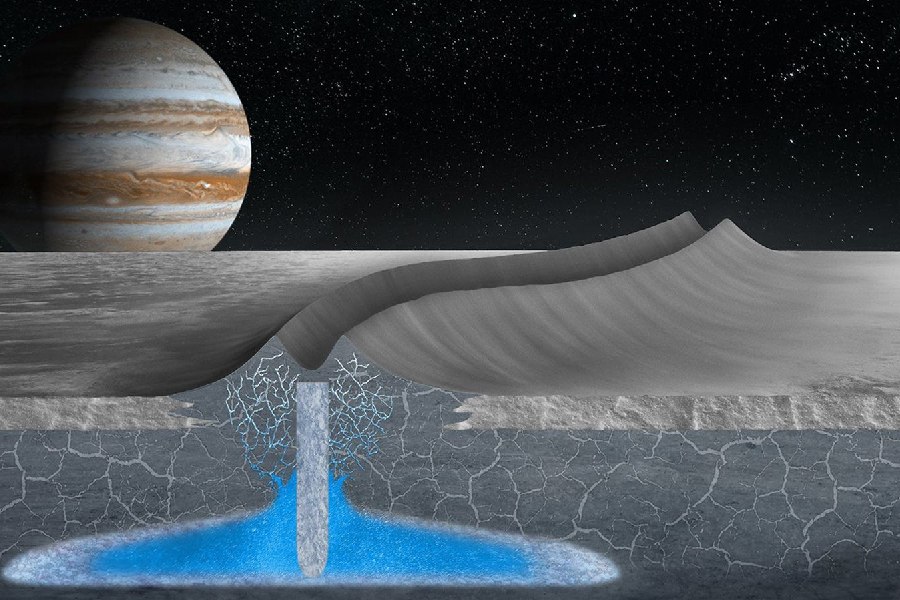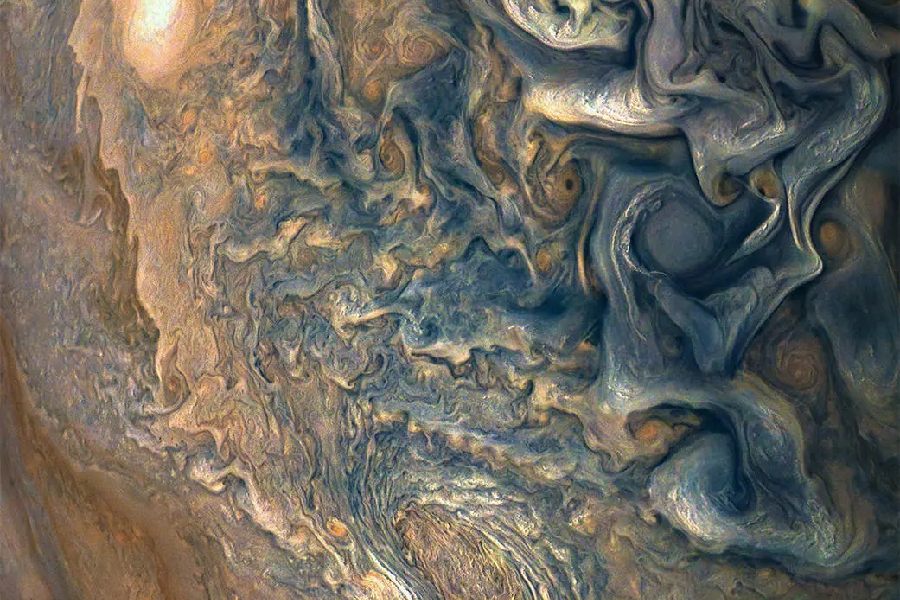Seen clearly in the night sky, Jupiter has captivated stargazers for millennia with its massive size and Great Red Spot. This gas giant planet leads astronomers to wonder: does Jupiter have water?
In this article, we will review what research and insights from space probes and Earth-based observations have indicated thus far about Jupiter’s environment and chemistry. We will explore whether these conditions could permit the formation or persistence of water.
Analyzing the types of clouds and the properties of possible water at extreme pressures and temperatures on Jupiter may reveal surprising conclusions about this planetary giant. Stay with us to uncover the truth about the existence of water on the gas giant Jupiter.

Does Jupiter Have Water?
Yes, Jupiter likely contains water, primarily in the form of vapor within its atmosphere and possibly as ice in its interior. While it lacks liquid oceans like Earth, water vapor plays a crucial role in forming Jupiter’s iconic cloud layers and atmospheric dynamics.
Observations from spacecraft missions and telescopes support the presence of water on Jupiter. This contributes to understanding the giant planet’s composition and behavior within our Solar System.
Recent discoveries
Recent discoveries have provided more insight into the potential presence of water on Jupiter. Ground-based telescopes and space probes employ detection methods to identify spectral signatures of water within the planet’s atmosphere.
The Galileo spacecraft conducted close passes to directly sample Jupiter’s clouds, using onboard instruments to analyze cloud materials. These instruments successfully identified both water ice and vapor. Additionally, through infrared mapping, water has been detected deep within Jupiter, likely existing as ice crystals or vapor, with occasional condensation closer to the surface.
Numerous flybys have also confirmed the presence of water. During its descent, the Galileo probe measured moisture, revealing that water constituted 0.13% of the area’s cloud composition. Subsequent studies further validated these findings, confirming that Jupiter indeed possesses water within its atmosphere.
The observational data stems from various exploration methods, including flybys, probes, infrared mapping, and ground-based telescopes. These findings have revealed the presence of water on Jupiter and confirmed its existence in different forms, such as vapor, ice, and liquid, within the planet’s cloud layers.
Composition of Jupiter
Jupiter’s composition is predominantly hydrogen and helium, making up over 99% of its mass. The remaining 1% consists of trace amounts of methane, ammonia, hydrogen sulfide, water vapor, and hydrocarbons. Its core, composed of heavier elements like rock and metal, is surrounded by a layer of metallic hydrogen under extreme pressure.
Above this layer lies Jupiter’s atmosphere, characterized by alternating bands of clouds made of various compounds, including ammonia, water, and ammonium hydrosulfide. These clouds create the distinct banded appearance seen on the planet’s surface.
Understanding Jupiter’s composition is crucial for unraveling its structure, behavior, and atmospheric dynamics. This provides valuable insights into planetary formation and evolution.
The transient presence of liquid water
The atmosphere on Jupiter creates pockets near the surface that allow liquid water to possibly exist there briefly. However, this only lasts a short time before evaporation happens.
The moisture then turns back into water vapor quickly. This turbulent atmosphere also facilitates the mixing of molecules, allowing water traces to likely appear at various altitudes as vapor, liquid, or solid ice crystals.

Atmosphere and Clouds
As mentioned, Jupiter’s atmosphere is mainly composed of hydrogen (90%) and helium (10%). Additionally, it contains small amounts of methane, ammonia, hydrogen sulfide, water vapor, and hydrocarbons.
The upper atmosphere experiences significant heating, causing molecules to spread out. This phenomenon may result in water existing as dispersed ice crystals and vapor. Distinctive features of Jupiter’s atmosphere include visible bands, zones, spots, and large storms within its cloud layer.
How does Jupiter’s atmosphere enable water?
The upper layer of ammonia ice clouds on Jupiter serves as a protective barrier and helps maintain stability for the lower water cloud decks. In regions of high pressure, the warmer water clouds briefly condense into liquid form before evaporating again.
These water clouds interact with the adjacent ammonia ice clouds, blending together at their boundaries. Jupiter’s powerful vertical air currents disperse the water molecules through atmospheric convection, lifting both vapor and ice crystals.
Moreover, swift winds move molecules swiftly in alternating east-west jet streams, leading to turbulent storm systems characterized by dense cloud formation and lightning activity. This dynamic atmospheric process allows for the cycling of trace water content.
Evidence for Water on Jupiter
Evidence shows that water exists on Jupiter, both directly and indirectly. Direct observations, like those from the Galileo probe, detected traces of moisture in the atmosphere. As it descended, the probe measured that 0.13% of the clouds held water.
Moreover, the Juno spacecraft, during its orbit around Jupiter, directly analyzed the planet’s cloud layers. It detected water vapor, liquid water droplets, and ice using its advanced equipment and microwave radiometer.
An actively cycling hydrologic system
Evidence suggests there’s a lot of water on Jupiter. This is based on what Jupiter is made of and its environment. Heat comes from inside the planet, warming the lower atmosphere and making it the right temperature for water vapor to turn into droplets.
When the droplets form, it shows there’s a lot of water. And when they’re exposed to different temperatures, they turn back into vapor.
The main things in Jupiter – hydrogen and oxygen – can make water when they come together. Even though only a little bit of water has been found compared to how big Jupiter is, there’s enough proof to show that Jupiter’s a water system, the biggest solar planet.
Conclusion
Does Jupiter have water? Jupiter harbors water within its vast atmosphere and possibly even in its interior. Evidence gathered from spacecraft missions, telescopic observations, and direct sampling via probes like Galileo and Juno confirm the presence of water vapor, liquid water droplets, and ice crystals on this gas giant.
Despite its turbulent and extreme atmospheric conditions, Jupiter’s composition and environment facilitate the existence of water in various forms, contributing to our understanding of this enigmatic planet’s dynamics. This makes it a fascinating world with potential implications for our understanding of planetary science.
